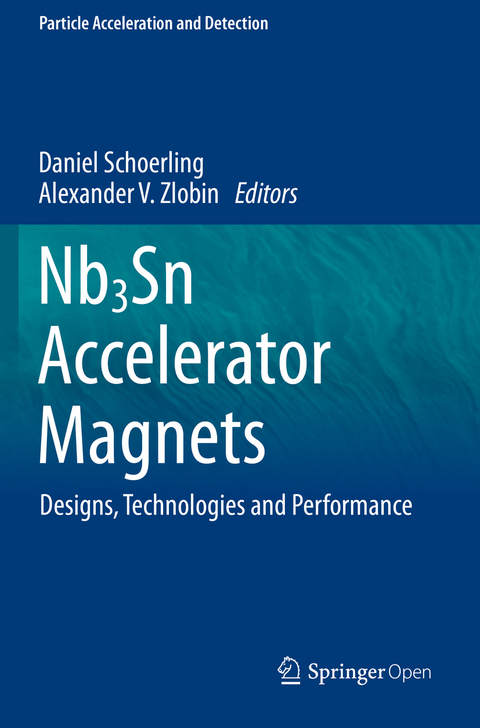
Nb3Sn Accelerator Magnets
Springer International Publishing (Verlag)
978-3-030-16120-0 (ISBN)
This open access book is written by world-recognized experts in the fields of applied superconductivity and superconducting accelerator magnet technologies. It provides a contemporary review and assessment of the experience in research and development of high-field accelerator dipole magnets based on Nb3Sn superconductor over the past five decades. The reader attains clear insight into the development and the main properties of Nb3Sn composite superconducting wires and Rutherford cables, and details of accelerator dipole designs, technologies and performance. Special attention is given to innovative features of the developed Nb3Sn magnets. The book concludes with a discussion of accelerator magnet needs for future circular colliders.
lt;p>Dr. Alexander Zlobin is a Senior Scientist at Fermi National Accelerator Laboratory (Fermilab). He received his M.S. degree in Physics in 1977 from the Moscow Engineering Physics Institute (MEPhI) and PhD degree in Beam Physics and Accelerator Technologies in 1991 from the Institute for High Energy Physics (IHEP) in Protvino, Russia. Since 1995 he is with Fermilab, where he is serving as the Leader of Superconducting Magnet Group and the Head of the High Field Magnet and Material R&D program. He is Fellow of the American Physical Society.
Dr. Daniel Schoerling is a Scientific Engineer at the European Organization for Nuclear Research (CERN). He received his M.Sc. degree in Engineering in 2009 and his PhD in 2012 from the Technical University of Freiberg, Germany. During his PhD research, performed in collaboration with CERN, he specialized on superconducting Nb3Sn accelerator magnets. Since 2011, he is with CERN working on normal- and superconducting accelerator magnet projects for several present and future machines like HL-LHC, LHC, CLIC, FCC, PS and ELENA.
Part 1. Introduction.- Chapter 1. SC magnets in particle accelerators (D. Schoerling).- Chapter 2. Nb3Sn strand and cable progress (E. Barzi).- Chapter 3. Historical overview (1960s-1980s) (L. Rossi).- Part 2. Cos-theta dipoles.- Chapter 4. CERN-ELIN (R. Perin).- Chapter 5. CERN-MSUT (A. den Ouden).- Chapter 6. LBNL D20 (S. Caspi).- Chapter 7. FNAL HFDA (A. Zlobin).- Chapter 8. FNAL/CERN MBH (F. Savary).- Part 3. Block-type dipoles.- Chapter 9. TAMU (P. McIntyre).- Chapter 10. LBNL HD (GL. Sabbi).- Part 4. Common coil dipoles.- Chapter 11. BNL (R. Gupta).- Chapter 12. LBNL (S. Gourlay).- Chapter 13. FNAL HFDC (A. Zlobin).- Part 5. Outlook.- Chapter 14. Nb3Sn accelerator needs for FCC (D. Tommasini).- Chapter 15. Summary/Conclusions (D. Schoerling).
| Erscheinungsdatum | 12.09.2020 |
|---|---|
| Reihe/Serie | Particle Acceleration and Detection |
| Zusatzinfo | XVII, 452 p. 292 illus., 171 illus. in color. |
| Verlagsort | Cham |
| Sprache | englisch |
| Maße | 155 x 235 mm |
| Gewicht | 844 g |
| Themenwelt | Naturwissenschaften ► Physik / Astronomie ► Atom- / Kern- / Molekularphysik |
| Naturwissenschaften ► Physik / Astronomie ► Hochenergiephysik / Teilchenphysik | |
| Schlagworte | Accelerator magnet design and technology • composite superconducting wire • Critical current density Jc • field quality • Hadron Circular Collider • high-temperature insulation • Lorentz Force • low-temperature superconducting magnet • magnet quench protection • magnet training • mechanical support structure • New generation accelerator magnets • open access • quench performance • Rutherford cable • stored magnetic energy • superconducting coil |
| ISBN-10 | 3-030-16120-X / 303016120X |
| ISBN-13 | 978-3-030-16120-0 / 9783030161200 |
| Zustand | Neuware |
| Haben Sie eine Frage zum Produkt? |
aus dem Bereich


